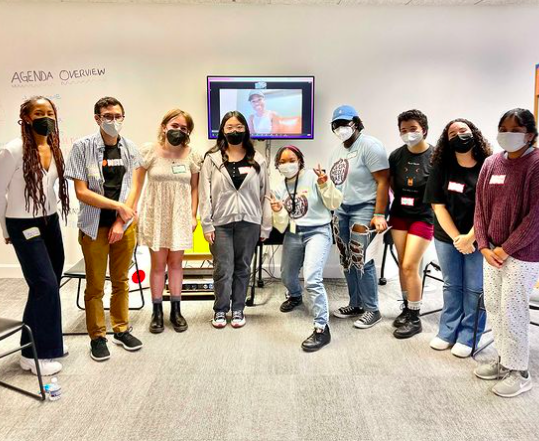On Feb. 24, Pixar animator Kelsey Mann came to Atlanta’s SCAD Show in Midtown for an early screening of “Onward” and to give a presentation to explain what exactly the story department does. Mann is the Head of Story on Pixar’s newest film, “Onward.” He started his animation career in a small Minneapolis-based studio called Reelworks. He joined Pixar in 2009, and has since worked on “Monster’s University,” “Toy Story 3,” and “The Good Dinosaur.”
As the Head of Story on a few movies at Pixar, he has focused on bringing the team together. If you’ve ever stayed to watch any movie’s credits scene, you know that there are a lot of people working on one film, but they have to create a unified product. Mann notes that in the smaller studios he’s worked at, the team is more together, and the bigger the studio is, the more isolated you get. To encourage this togetherness he has implemented several policies, the biggest of which being what he calls “The Fishbowl.”
“The Fishbowl” is a centralized room where anyone working on the film can go to work. Mann showed several pictures of this chaotic room, with several cluttered desks in the center, and all sorts of couches and seating around the edges. “The Fishbowl” has an open-door policy, so no matter what is going on inside, anyone can go in. Though you don’t have to do your work in it, the room provides a place for members of the “Onward” team to come together and bounce ideas off each other, learn what is going on in other sections of the film, or, in one video he showed, sing along to “Mulan.” He says that since animators don’t get the experience of being on set, this is as close as they get.
Mann showed us a few pictures of the very first day of work on “Onward.” First, was just a picture of the crew, then a shot of a blank story room with no cards on the walls. Reportedly, he thought “Omigosh this is, hold on, this is the beginning” and then took a picture to capture it. Then he revealed the date the picture was took: September 17, 2013. This film has been in the works for 7 years. For reference, in 2013 Disney released “Frozen,” and the iPhone 5s had just come out. Over the course of the storyboarding process, they drew a grand total of 97,759 cards, many of which weren’t even used in the plot of the final film, and none of which actually went into the movie.
Here’s The Pixar Story Process, according to Kelsey Mann:
Meet with the director to get your scene assignment: The story artist will meet with Dan Scanlon, the writer, and Kelsey Mann to talk about the idea behind a section of the script. Scanlon will read through the script and add in little details of what he sees in his head, during which Mann and the story artist will frantically take notes on what he is saying. Sometimes Dan will even show a pose that he envisioned, which the artist can use as a reference to sketch out.
Go off and sketch the scene out, shot by shot: Each story artist has his own method on how to do this. Some start in a notebook, or on sticky notes, drawing each a few frames for each shot, and others just start directly onto the iPad. They can do this in their own office, the Fishbowl, or anywhere else on the Pixar campus. The goal of these drawings is not to be beautiful and perfect, but instead convey idea clearly, since none of this will actually be in the final movie.
Pitch to the group and get feedback: The Pixar Pitch has developed a whole culture of its own. The story artist will put their frames into a Pixar software called Pitch Doctor, which they can then scroll through like a PowerPoint. As many people as are available will then gather in the Fishbowl to watch, including Scanlon and other managers. The pitch is made to be as close to the end scene as possible, with the goal being that the audience forgets they are watching a pitch and it feels like the actual movie. The pitcher will put on a little performance, matching the tone, timing, and even mimicking the sound effects of the finished scene. When they finish everyone will applaud and then Dan Scanlon will give his notes. Once he finishes he will open it up to the group. The artist can write down the notes or quickly redraw the panels. They can decide to scrap the scene or rework it.
Redo scene based on feedback: The story artist will then rework their scene and pitch it again until it’s good. In the scene Mann showed us, Trust Bridge, they decided to adjust the angle and order of two shots to better put the audience better into the protagonist Ian’s shoes.
When satisfied it will be sent to editorial who will add temporary sound effects and record “scratch” voices saying the lines that aren’t actually the famous people voice acting the roles: Mann tells us that, while not all people enjoy recording scratch, it’s one of the more fun parts of the job for him. Anyone working on the movie is offered the opportunity to be a scratch actor. In fact, Scanlon, the director, scratch acted for Ian in the preview shows.
Every three months, string together all of the scenes you have with the sound and show the screening: They hold a screening of the current plot every three months. For “Onward,” there were eight of them and one test audience. This is where they string together all of the dubbed scenes and see how it plays out.
Afterward, the “Braintrust,” a group of Pixar executives, will review their notes about the movie. If you saw the screening but weren’t a member of the Brain Trust, you can send in notes on an internal Pixar website: The Braintrust meets in a large conference room and each presents their notes and possible solutions. Submitted reviews are compiled by a team member who analyzes them for trends in what people liked or didn’t like.
The story group will meet up and decide what to do with the notes, then start again: The story team will then meet in the “editorial bank” where they can edit the movie as a whole, and decide what to do with the reviews. As Kelsey Mann said “We have to address the spirit of the note, but we don’t necessarily have to take their ideas.
Three months later, there is another preview: The team then repeats the process to prepare for the next preview in three months, with a — hopefully — improved movie.





This review of Pixar was detailed personified! Personally, I think this composition should be given to the Drama committee at your school….at least as a beginning…incredible great job…really proud ..2xBrownie points!